Excerpts from Jim Conrad's
Naturalist Newsletter
from the November 22, 2015 Newsletter issued from Hacienda Chichen Resort beside Chichén Itzá Ruins, central Yucatán, MÉXICO
BARBULA MOSS
Descending from the Hacienda's open-walled restaurant to the sidewalk skirting the prettily gardened back lawn, one meets a chest-high, columnar stone carving so eroded by time that you can barely make out the features in it of a person's face. The face shows high cheekbones and oversized, Oriental-type eyes, the kind of eyes often seem among living Maya today, and surely like those of the ancient Maya who built Chichén Itzá. That's the stone below:
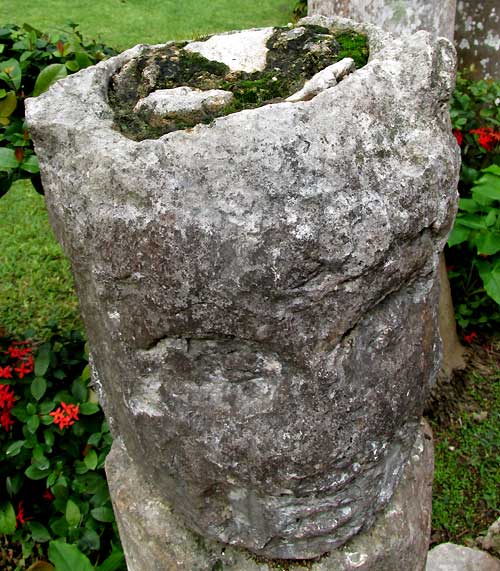
It's not surprising that real archaeological artifacts might turn up at the Hacienda. Until fairly recently in the Hacienda's long, interesting history, the grounds of Chichén Itzá ruins and those of the Hacienda were practically the same, the entire zone being owned by the same family. The current fences and tight security around the ruins are relatively new.
More interesting to me than the carving with its Oriental features is the depression atop the head, maybe chiseled there to receive the foot of a similar head-carving to be set above this one, or possibly to hold a pot of flowers. A worthy function the depression accomplishes now is to support an ecosystem of soil populated by tiny green plants and an assortment of microscopic and near-microscopic animals, such as a healthy colony of tiny white springtails. Most of the biomass in the cavity, however, is contributed by a kind of moss, a close-up of which is shown below:
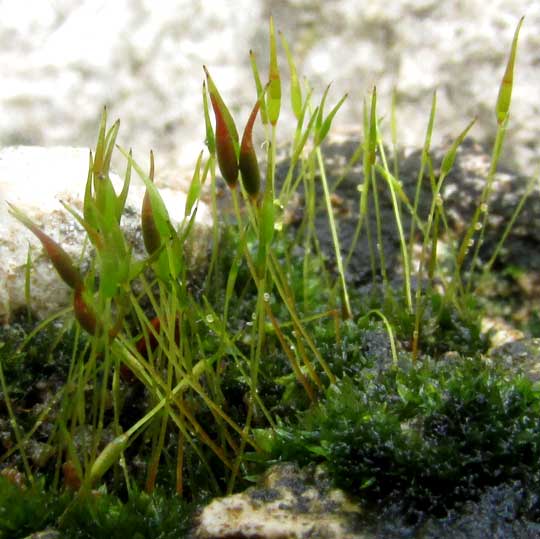 .
.
In the Yucatan, mosses are nearly as hard to find as fungi, the Peninsula's somewhat arid climate and long, severe dry seasons accounting for the paucity of both. In general, both mosses and fungi need more humid environments. Moreover, in the Yucatan, even when you do notice a colony of mosses, usually they're strictly vegetative, lacking spore-filled capsules atop slender stalks -- such as those seen towering over the mosses' leaves in the above picture.
Having no microscope and with all my moss books moldering up North, at first I thought there'd be no chance of my identifying this moss. However, it occurred to me that in our area the known moss flora must be very small, so maybe if I could find a list of Yucatec moss species, then compare illustrations of every species on the list with our moss, maybe there'd be a match. But, to see all the features needed to do this, I'd need to push my little from-the-Wal-Mart-shelf Canon PowerShot SX160 IS camera to the limits of its macro capacity, and work hard with PhotoShop.
First, let's see what three entire moss bodies, averaging about 1cm high (3/8ths inch), look like, as shown on the tip of my finger below:
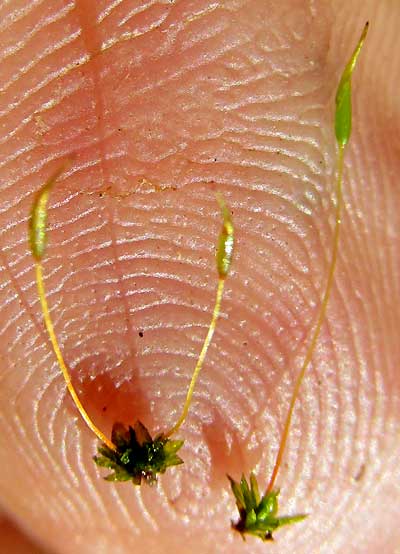
Unlike many moss species, these plants are nearly stemless, and atop hairlike stalks their spore-bearing capsules display long-pointed tops. The capsules do not nod downward from the tips of crookneck stalks as in some important moss genera. Closer up we see that the capsules' long, slender tops are actually dunce-cap-like affairs composed of cellophane-like cones that turn brown at maturity, shown below:
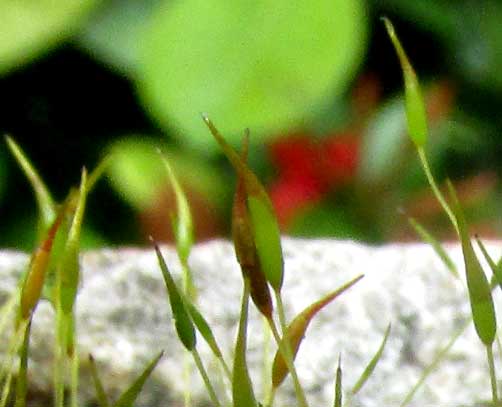
The dunce caps and other features of moss anatomy are discussed and illustrated on our Moss Page at www.backyardnature.net/mosses.htm.
Studying our last picture closely, we see that each dunce cap, or calyptra, is shaped like an upside-down cone with a broad, shallow split along one side, and that's a field mark worth noting.
A close-up of a moss's tufted leaves is shown below:
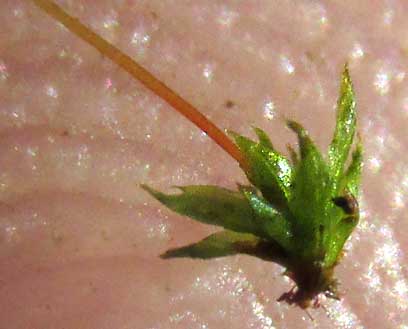
That shot reveals two important details: First, the leaves are sharply tipped, and; second, each leaf bears a prominent midrib down its back.
Up North in moss-rich areas these features would be completely inadequate for identification. However, down here where so few species are to be reckoned with, maybe...
On the Internet the breakthrough came when I downloaded a 2003 paper by Claudio Delgadillo M. entitled "Moss Distribution in the Yucatán Peninsula."
Delgadillo tells us that about 70 moss species and varieties occur in the Yucatan Peninsula, with the rainier southern region being the mossiest. He also helpfully mentions that certain species are found only on trees, such as Calymperes afzelii, Entodontopsis leucostega, Henicodium geniculatum, Leucobryum incurvifolium, and Octoblepharum albidum, while others restrict themselves to limestone, such as Barbula agraria, Barbula indica, Hyophila involuta, and Neohyophila sprengelii.
Beyond its other values, the carved Maya head outside the Hacienda's restaurant amounts to being a hunk of limestone, and in light of Delgadillo's list of limestone-loving mosses, that fact turns out to be critical to our ID effort.
Looking up pictures and drawings of the four species listed as growing on limestone -- as being "obligate calcicolous species," as Claudio Delgadillo says it -- images of only one species match ours, and they match in every detail we can see.
Therefore, despite this ID technique being so unprofessional, I feel pretty sure that our head-carving moss is the first on Claudio Delgadillo's list, the one he calls Barbula agraria, but which nowadays the updated Flora of North America names HYOPHILADELPHUS AGRARIUS.
The Flora describes Hyophiladelphus agrarius as forming low crusts, often with cyanobacteria, in low, shady, moist areas on limestone and masonry walls. It's found in the US southeastern states south through Mexico and Guatemala, plus the Caribbean area, and northern South America and Brazil. Sometimes it's referred to as the Barbula Moss, though it no longer belongs to the genus Barbula.